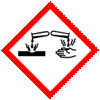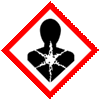Formaldehyde Solution SDS of Suppliers Exporters, Manufacturers
Please visit Main Page of Formaldehyde Solution Manufacturers.
Formaldehyde Solution (with Methanol) SDS Safety Data Sheet
MSDS Sheet, Material Safety Data Sheet
1. Product Identification
Product Name & Other Names: Formaldehyde Solution or Formalin (with Methanol)
CAS No.: 50-00-0
EINECS EC Code: 200-001-8
2. Hazards Identification
GHS, Globally Harmonized System Classification in accordance with 29 CFR 1910
Classification according to Regulation (EC) No 1272/2008
Acute toxicity, Oral (Category 3), H301
Acute toxicity, Dermal (Category 3), H311
Acute toxicity, Inhalation (Category 3), H331
Skin corrosion (Category 1B), H314
Skin sensitization (Category 1), H317
Germ cell mutagenicity (Category 2), H341
Carcinogenicity (Category 1B), H350
Specific target organ toxicity - single exposure (Category 1), H370
Specific target organ toxicity - single exposure (Category 3), Respiratory system, H335
Labeling according to GHS USA & Regulation (EC) No 1272/2008
GHS Label Elements  Toxic |
GHS Label Elements |
GHS Label Elements |
Signal Word: Danger
Hazard Statements:
H301+H311+H331 Toxic if swallowed, in contact with skin or if inhaled.
H314 Causes severe skin burns and eye damage.
H317 May cause an allergic skin reaction.
H335 May cause respiratory irritation.
H341 Suspected of causing genetic defects.
H350 May cause cancer.
H370 Causes damage to organs.
Precautionary Statements
P202: Do not handle until all safety precautions have been read and understood.
P260: Do not breathe dust/fume/gas/mist/vapors/spray.
P264: Wash ... thoroughly after handling.
P270: Do not eat, drink or smoke when using this product.
P271: Use only outdoors or in a well-ventilated area.
P280: Wear protective gloves/protective clothing/eye protection/face protection.
P301+P310+330: IF SWALLOWED: Rinse mouth and immediately call a POISON CENTER or doctor/physician.
P302+P352: IF ON SKIN: Wash with soap and water.
P304+P340: IF INHALED: Remove victim to fresh air and keep at rest in a position comfortable for breathing.
P305+P351+P338: IF IN EYES: Rinse cautiously with water for several minutes. Remove contact lenses, if present and easy to do. Continue rinsing.
P308+313: IF exposed or concerned: Get medical advice/attention.
P314: Get Medical advice/attention if you feel unwell.
P360: Rinse immediately contaminated clothing and skin with plenty of water before removing clothes.
3. Composition/Information on Ingredients
Ingredient I: Formaldehyde 30-45% in water.
CAS No.: 50-00-0
EINECS EC Code: 200-001-8
Ingredient II: Methanol 5-20% in water.
CAS No.: 67-56-1
EINECS EC Code: 200-659-6
4. First Aid Measures
Always seek medical attention after first aid measures are provided.
Inhalation: Remove the victim to fresh air. If not breathing, give artificial respiration. If breathing is difficult, give oxygen. Get medical attention.
Ingestion: Do NOT induce vomiting. Never give anything by mouth to an unconscious person. Rinse mouth with water. Contact medical center quickly. Never give anything by mouth to an unconscious person. Get medical attention.
Skin Contact: Immediately flush skin with plenty of water for at least 15 minutes. Remove contaminated clothing and shoes. Get medical attention. Wash clothing before reuse. Thoroughly clean shoes before reuse.
Eye Contact: Check for and remove any contact lenses. Immediately flush eyes with running water for at least 15 minutes, keeping eyelids open. Cold water may be used. Get medical attention.
5. Fire Fighting Measures
Fire: Flash point: Not available.
Toxic fumes, carbon dioxide and carbon monoxide may be formed in fire.
Fire Extinguishing Media: Dry chemical, foam or carbon dioxide and water spray jet.
Extinguishing Media Not recommended: None specified.
Special Information: In the event of a fire, wear full protective clothing and NIOSH-approved self-contained breathing apparatus with full face piece operated in the pressure demand or other positive pressure mode. At elevated temperatures under fire conditions, it may produce toxic or irritating fumes. Fire-extinguishing work is done from the windward and the suitable fire-extinguishing method according to the surrounding situation is used.
6. Accidental Release Measures
Personal precautions, protective equipment, and emergency procedures: Avoid breathing dust/fumes/gas/mist/vapors/spray. Use individual protective equipment (waterproof boots, suitable protective clothing, safety glasses, etc.). Restrict unprotected personnel from the area. Prevent any contact with hot surfaces. Do not approach facing the wind.
Environmental precautions: Do not let the product enter drains, soil, or water sources.
Methods and materials used for containment cleanup procedures and Storage: Contain spilled material. Absorb with an inert, non-combustible absorbent material, (e.g., sand, earth, diatomaceous earth, vermiculite). Vacuum or sweep up and remove to an approved disposal container. Avoid mist formation. Keep away from heat. Keep away from sources of ignition. Provide ventilation.
7. Handling and Storage
Precautions for safe handling: Apply according to good manufacturing and industrial hygiene practices. Ensure proper ventilation. Wash thoroughly after handling. Do not drink, eat, or smoke while handling. Avoid contact with skin, eyes, and clothing. Minimize dust generation. Avoid breathing dust/fumes/gas/mist/vapors/spray. Avoid ingestion and inhalation. Use individual protective equipment (waterproof boots, suitable protective clothing, safety glasses, etc.). Prevent any contact with hot surfaces.
Conditions for safe storage, including any incompatibilities: Store in cool, dry, and ventilated area away from heat sources and protected from sunlight in tightly closed original container. Keep air contact to a minimum. Do not leave the material container open. Store protected from heat, sparks and ignition sources and incompatible materials. Do not store with incompatible materials like strong oxidizing agents, aniline, phenol, isocyanates, acid anhydrides, strong acids, strong bases, amines, peroxides, acid chlorides, alkali metals, reducing agents. Containers of may be hazardous when empty.
8. Exposure Controls/Personal Protection
Airborne Exposure Limits:
Formaldehyde 37%, in Aqueous Solution
ACGIH: TLV-C 0.3 ppm
USA OSHA: PEL (TWA) 0.75 ppm
USA OSHA: PEL (STEL) 2 ppm
USA IDLH: 20 ppm
Methanol
ACGIH: TLV-TWA 200 ppm
ACGIH TLV-STEL: 250 ppm
USA OSHA: PEL (TWA) 260 mg/m³
USA OSHA: PEL (TWA) 200 ppm.
Ventilation System: A system of local and/or general exhaust is recommended to keep employee exposures as low as possible. Local exhaust ventilation is preferred because it can control the emissions of the contaminant at its source.
Personal Respirators (NIOSH Approved): For conditions of use where exposure to the substance is apparent and engineering controls are not feasible, consult an industrial hygienist.
Skin Protection: Wear impervious protective clothing, including boots, gloves, lab coat, apron, or coveralls, as appropriate, to prevent skin contact.
Eye Protection: Use chemical safety goggles and/or a full-face shield where splashing is possible. Maintain eye wash fountain and quick-drench facilities in work area.
Other Control Measures: Maintain good housekeeping in work area.
9. Physical and Chemical Properties
Appearance: Clear liquid.
Odor: Typical aldehyde pungent smell.
Odor threshold: Not available.
pH: Not available.
Relative density: around 1.09
Boiling Point: >100C
Melting Point: Not available.
Flash point: Not available.
Auto-ignition temperature: Not available.
Decomposition temperature: Not available.
Upper/lower flammability or explosive limits: Not available.
Vapor pressure: Not available.
Vapor density: Not available.
Evaporation rate: Not available.
Flammability (solid, gas): Not available.
Partition coefficient: n-octanol/water: Not available.
Solubility: miscible with water
Viscosity: Not available.
10. Stability and Reactivity
Stability: Formaldehyde is stable under ordinary conditions of use and storage with the stabilizer.
Hazardous Decomposition Products: Carbon dioxide, carbon monoxide and toxic fumes may form when heated to decomposition.
Incompatibilities: Strong oxidizing agents, Aniline, Phenol, Isocyanates, Acid anhydrides, Strong acids, Strong bases, Amines, Peroxides, Acid chlorides, Alkali metals, Reducing agents, Heat.
Conditions to Avoid: Heat, flames, ignition sources and incompatibles.
11. Toxicological Information
Oral rat LD50: No data found
The product is listed as carcinogen, Group 1: Carcinogenic to humans (Formaldehyde).
Warning: contains methanol. May be fatal or cause blindness if swallowed.
Mutagenic Effects: No data found.
Reproductive Effects: No data found.
12. Ecological Information
Environmental Toxicity: Toxic to fish and aquatic life.
Results of PBT and vPvB assessment: This substance/mixture contains no components considered to be either persistent, bioaccumulative and toxic (PBT), or very persistent and very bioaccumulative (vPvB) at levels of 0.1% or higher.
13. Disposal Considerations
Whatever cannot be saved for recovery or recycling should be managed in an appropriate and approved waste disposal facility.
14. Transport Information
DOT USA, TDG Canada & ADR/RID Europe
UN Number: 2209, Class: 8, Packing group: III
Proper shipping name: Formaldehyde solution
IMDG/IMO
UN Number: 2209, Class: 8, Packing group: III
Proper shipping name: Formaldehyde solution.
ICAO/IATA
UN Number: 2209, Class: 8, Packing group: III
Proper shipping name: Formaldehyde solution.
15. Regulatory Information
No additional information is available.
Section 16 - Additional Information
DISCLAIMER: The information and recommendations set forth herein are presented in good faith and believed correct as of the date hereof. It is compiled from various sources, and it is not necessarily all inclusive nor fully adequate in every circumstance. In addition, these suggestions should not be confused with nor followed in violation of applicable laws, regulations, rules, or insurance requirements applicable. This SDS MSDS sheet is intended only as a guide to the appropriate precautionary handling of the material by a professionally trained person using this product. Individuals receiving the information must exercise their independent judgment in determining its appropriateness for a particular purpose. This shall not constitute a guarantee for any specific product features and shall not establish a legally valid contractual relationship. In no case shall our company be liable to loss or damages by the product user.
Please visit Technical Data Sheet of Formaldehyde Solution BP Ph Eur USP Grade Manufacturers.
Formaldehyde Solution BP Ph Eur USP Grade CAS Number 50-00-0 Supplier Exporter, Manufacturer:
Annie Chemie P Ltd
Mumbai 4000010, INDIA
With Agents and offices in UAE, USA, Europe.
e-mail: info@anniechemie.com
Copyright and Usual Disclaimer is Applicable.
May 31, 2025
Exporters to USA, Canada, UK, Europe, UAE, Nigeria, Algeria, Turkey, Mexico, Brazil, Chile, Argentina, Australia, Dubai etc.
Perfection is made up of small things and that is a big thing.


